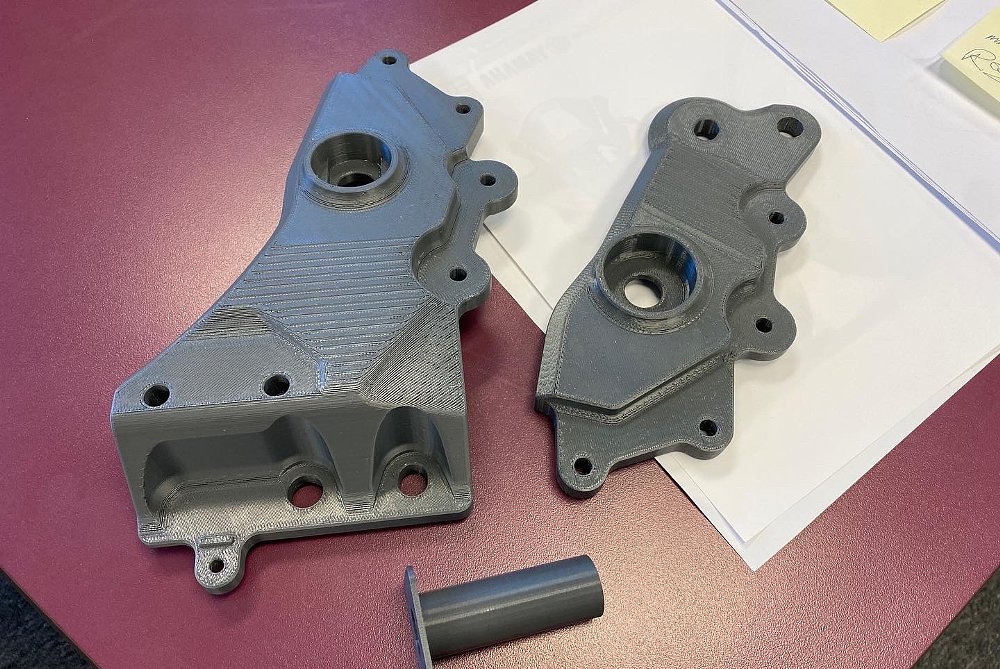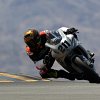Session after session and lap after lap, the Yoshimura race team gathers at pit wall along Chuckwalla Valley Raceway’s front straight to watch their YZF-R7 project circulate the track.
On the bike, I try to focus on my brake marker for Turn 1, but it’s impossible to avoid sneaking a glance at the row of faces.

Yoshimura R&D is building a Yamaha YZF-R7 race bike for the MotoAmerica Twins Cup race at WeatherTech Raceway Laguna Seca next month and has invited Common Tread staffer Ari Henning to ride it. If you missed it, see his previous report on the beginning of the project.
Company CEO, Yusaku Yoshimura, appears tense, while former Yoshimura Racing crew chief Daisuke Hashimoto and technician Sean Storment wear the calm, analytical gaze of seasoned pros, albeit possibly underwhelmed with their rider’s skill. Down the wall, Kenny Kato, the veteran Yoshimura Racing engine builder, is visibly anxious for the R7’s unfamiliar and untested engine internals as they spin well beyond the factory rev limit in unprecedented heat. Eric Steen, the easygoing R&D department manager that’s heading up this R7 project, is often smiling, but his face betrays an added degree of satisfaction today. Then, there’s Ricardo Mendoza, one of the R&D team’s newest hires. Ricky, 27, only began riding a few years ago, and now he’s here, doing this. He’s beaming so hard his cheeks are probably going to cramp.
At the helm of the R7, I’m smiling too. I love ripping around on motorcycles, even when it’s 105 degrees out, and I can’t believe Yoshimura has entrusted me with the responsibility of riding this bike.

My role is to pilot the R7 as quickly and consistently as possible as we put it through a battery of tests, then provide what feedback I can to crew chief Daisuke to supplement the data he extracts from the aRacer ECU with its various sensors. Each session is an experiment to see how the R7 responds to changes in suspension settings, chassis geometry, wheelbase, tire compound and pressure, gearing, and myriad other adjustments. Yoshimura is accustomed to being intimately familiar with its race bikes, so this early on, we’re just getting acquainted with the R7, gaining knowledge, and hopefully moving the bike in a direction that will give me the confidence to push come race day.

Thankfully, the R7 is already pretty easy to manage, because even if it’s a long way from being fully built and sorted, it was still assembled by a team of pros. Daisuke, previously a Showa chassis tech for Nicky Hayden on Honda’s MotoGP team, has totally reworked the chassis and optimized it for on-track performance. There are the usual mods like an Ӧhlins TTX shock and a YZF-R6 front end with Ӧhlins FXR cartridges, but the bike is also wearing a triple clamp with adjustable offset, prototype frame plates that change the swingarm-pivot height, and a freshly machined shock linkage that alters the rear suspension’s leverage ratio.
Of course, Kenny’s engine is outstanding. In stock form Yamaha’s YZF-R7 has a stout midrange, but the 689 cc twin runs out of steam beyond 7,500 rpm. Jen said it best in our review of the R7: It’s quick, but not fast. Compare that to the Yoshimura-built YZF-R7, which outpaces 600s in the midrange and keeps pulling hard all the way past 11,000 rpm. That’s the result of a compression ratio that's two points higher, more aggressive cams, head work, a bespoke titanium exhaust, and various other speed secrets that I won’t discuss here. After all, our competition might be reading this.

The bike — and the team — have come a long way since February, when I first met with Yoshimura to discuss racing a YZF-R7 in the MotoAmerica Twins Cup at Laguna Seca in July. That day, the R7’s chassis was still stock and the freshly built race engine had just been heat cycled on the dyno. The plan at the time was to conduct five track tests before the race, with the first outing scheduled for early March.

That initial test got pushed back. Twice. “We really bit off more than we could chew,” recalls Eric. “We were lacking tools and equipment that was sold when the race shop closed, and we had issues securing parts for the bike since we’re working with so many new vendors.” And of course time was a huge constraint, with the race project competing for hours with normal production duties that actually pay Yoshimura’s bills.

Internally, aligning the schedule of Jared Lozonne, the exhaust builder, with Kenny’s timeline for engine development and Daisuke, Sean, and Ricky’s need to tear into the chassis required careful coordination. Eric keeps things on track with weekly meetings, where he presents a lengthy punch list and gets updates from stakeholders. From an organization perspective, the team is already operating like a well-oiled machine thanks to existing processes that allow the R&D department to juggle multiple projects during its routine work.
At the track during that first test in April, it was a different story, at least in Yusaku’s assessment. “To be honest, it was a little messy,” says Yusaku. “The pit setup wasn’t right and we didn’t have our responsibilities figured out.”
Given the bitchin’ equipment on hand and how much work got done (in just a matter of hours the nascent Yoshimura race team made more revisions to the bike and swapped out more parts than most high-level amateur racers would undertake in a full season), it looked pro to me, but I understand Yusaku’s perspective. The excitement among the less experienced team members (read: everyone except Daisuke and Sean) was palpable, and we all wanted to lend a hand doing everything. It made for a somewhat chaotic and crowded scene around the bike.

For the second test in mid-May, the paddock had a better layout (the guys practiced and refined the footprint in their parking lot) and was well organized, but more importantly, each team member had been assigned specific roles and responsibilities. That reduced entropy and increased the team’s efficiency exponentially, and on more than one occasion I noticed passerby stopping to watch, transfixed by the operation. “The structure and organization,” commented Don Sakakura, who audited the second test, “that was good to see. That’s the way it needs to be.”

As for me, well, my job was simple: ride. Coming into this project I had visions of wrenching alongside the techs, but I only touched the bike once my leathers were on. At first I thought my role was too easy, but it’s a lot more mental work than I anticipated.

Consider that every session we made adjustments to the bike, not all of which made it easier to ride. The R7 was never the same machine from one sweltering-hot stint to the next, yet as the development rider you have to pilot it at a pace that will reveal whether or not the most recent change improves or inhibits lap times. With gearing and ergonomic tweaks, that’s easy and ultimately inconsequential. But when you’re trying to tame persistent front-end chatter that appears at lean during the last 10 percent of trail braking — a fairly insidious handling problem that’s difficult to ride through — the stakes are higher, because whatever new setting you’re testing might make the chatter worse.

I’ve never been particularly adept at chassis tuning, and with this team, I don’t have to be. Daisuke and I confer every time I come off the track, but the bulk of the information he needs is retrieved via data cable, not conversation.
RPM, speed, throttle position, GPS location, and gear position are all presented on Daisuke’s monitor, but what he’s interested in now is front and rear suspension travel and stroke speed. He’s been adjusting the settings to bring the chassis “into balance,” and with this data Daisuke can literally see how the fork and shock are moving and overlay that empirical information — filtered through his vast knowledge — onto my feedback to enact further changes. The quantity and quality of information is mind-blowing; features of a rarefied world that I’ve only ever glimpsed in team garages at top-level races.
At another table, Kenny furrows his brow as he reviews engine data with Ricky and aRacer’s Kae Chang. Coolant and oil temperatures are too high; add it to the list of issues to address when the team gets back to the R&D shop. The roster already includes the belly pan scraping the pavement and wearing through at high lean angles, non-functioning traction control, a slipper clutch and electronic engine braking that won’t cooperate, and of course the aforementioned front-end chatter, but nobody seems worried. “This project keeps throwing surprises at us,” says Eric, “but considering how well the team is operating now, and what we’ve already managed to accomplish, I’m not intimidated.”

“Both times they’ve come back from the track, the guys have been so excited, so energized,” says Don. That’s good, because there’s still a lot of work to accomplish. We have one more track test scheduled for late June, and then the next time the team lines up along a paddock wall to watch their R7 project, it’ll be for the MotoAmerica Twins Cup race, where all of their effort from the preceding six months will boil down to one 13-lap race.


















